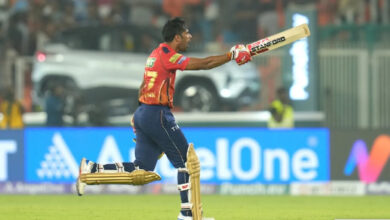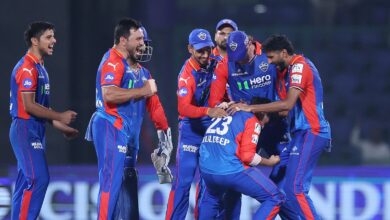Meet the real stars behind Sri Lanka’s amazing triumph in Asia Cup

Two familiar names—Wanindu Hasaranga and Bhanuka Rajapaksa—were the chief protagons of Sri Lanka’s fairytale Asia Cup triumph. But there were unfamiliar and understated names that played an equally pivotal role in scripting a triumph that could potentially restore the old glory of Sri Lankan cricket.
Dasun Shanaka, the Captain Cool
Sri Lanka’s captain Dasun Shanaka, third right, and teammates pose with the winners trophy after their win in the T20 cricket Asia Cup final match against Pakan, in Dubai. (AP Photo/Anjum Naveed)
The all-rounder was never earmarked as a future captain. When he became the captain last year, he was not even a permanent fixture of the team. There was public outcry and prime-time television debates. But there, practically, were few other alternatives. Kusal Perera, the captain, and senior player Kusal Mendis, were banned for breaching Covid-19 protocol. Rajapaksa too was banished for giving interviews blasting selectors and the board. Hasaranga was reluctant. The crown of thrones fell on Shanaka’s head. The early days were tumultuous, a public spat over tactics with then coach Micky Arthur, became scandalous. Defeats piled on—before the Asia Cup, Sri Lanka had lost 10 off their last 14 games. An economic crisis was blowing in his country. There was an all-round disillusionment.
But throughout all the mess, Shanaka remained cool. He gradually built a team, picking the players he wanted, instilling confidence and leading from the front. The Afghanan game aside, he made all the right moves, the right field changes and rang in the perfect changes. Like drafting, Dhananjay de Silva and handing out debut to Pramod Madushan in the last super four game against Pakan. Madushan was to pick four wickets in the final, de Silva cracked a glorious 24 to allay the early pressure. Even when some of the senior players were going through a rough patch, he kept faith in them and they eventually blossomed. Like Kusal Mendis, Sri Lanka’s top-scorer in the tournament, or his partner Pathum Nissanka. When bowlers got hit or the fielders dropped catches, he would wrap an arm around them. When shoulders dropped, he would egg them on. When someone made a dazzling save, he would be first to congratulate him. After a long time, Sri Lanka have looked like a team.
Now, that’s how champions celebrate! 🎉https://t.co/ruP7lLtgnH!
➡️Send us your celebration video using the hashtag #RoaringForGlory ! pic.twitter.com/LpijSdLaAq
— Sri Lanka Cricket 🇱🇰 (@OfficialSLC) September 11, 2022
Even in the press conference, he stood for the players and requested that the media spared their personal lives. “Believe in our cricketers,” he said. “A lot of bad things are going around. As cricketers, they too should enjoy their lives as well, not spreading bad things. They have private lives too. Keep believing, that is the key. As a captain, I give confidence to the players, [whatever] I can. I can’t ask more than that.”
But at the same time, he is stern when he has to be. After the shoddy batting display against Afghanan, he sounded out the batsmen to lift their game. He spoke to them individually and told them that none of their spots in the World Cup was secure. “We knew we had the talent, but it was about applying those in game scenarios. So we had a discussion and all the players stood up. It’s the environment we created as a team and coaching staff that has paid off.”
Former coach Arthur was effusive in his praise. “Dasun is special in that he has great belief in himself and empowers the team. He leads example in his performance, training and practice and has the ability to take people on the journey with him,” Arthur told Sunday Island.
The most striking feature of his captaincy is that he does not seem to take it as a burden but as a “pleasure” in his own words.
Dilshan Madushanka, pace-setter
Sri Lanka’s Dilshan Madushanka reacts after bowling out India’s Deepak Hooda during the T20 cricket match of Asia Cup between Sri Lanka and India, in Dubai, United Arab Emirates, Tuesday, Sept. 6, 2022. (AP Photo/Anjum Naveed)
Before the tournament, he was just another promising fast bowler. In the last decade, Sri Lanka has seen many such bowlers, who promise potential but would then freeze at the international stage. But not Madushanka, who has seamlessly transitioned into the global stage. The left-armer is fast, can seam the ball either ways, can generate awkward bounce though he is not a beanpole and has a streak of aggression that some Sri Lanka’s pacemen have been bereft of. He got the wicket of Virat Kohli, troubled Babar Azam in both the Super Four and the final, won the admiration of Wasim Akram, who likened him to a young Chaminda Vaas.
His emergence caps a memorable back story. From a fishing village in the port city of Hambantota—when at home he still accompanies his father to the sea—he had not seen a leather ball until he was 17. He used to play soft ball cricket in the locality, not because he was too fond of the game but because he could earn some money and support his father. “Until the day I came to Colombo for Sri Lanka under-19 practices, all I did was play soft-ball cricket. We went for all the tournaments around. We were never at home during weekends. At times we played tournaments through the night and returned home only in the evening of the following day,” he told papare.com
For most of the soft-ball career, he played barefoot and almost quit the game because he could not afford the equipment. But one day, he saw a notification of the country’s U-19 trials and decided to attend it. He borrowed a ragged pair from his friend and bowled his heart out at the trials. The next day, he got a call from an unknown number on his rickety third-hand cell-phone. Turns out to be Chaminda Vaas, the then U-19 coach. Two days later, he joined the U-19 team and two years later, transitioned to the national side, living a dream beyond his wildest dream.
Pramod Madushan, old kid on the block
Sri Lanka’s Pramod Madushan celebrates after taking the wicket of Pakan’s Fakhar Zaman. (REUTERS/Chropher Pike)
The right-arm seamer’s story is one of persence, his journey the exact opposite of Madushanka. A medium pace rather than pace bowler in his early days, he barely got a decent string of chances on the spinner-friendly tracks in his country. He made his first-class debut in 2015, but in seven years has featured in just 31 games. He changed clubs, but the fate remained the same. So much so that he had made up his mind to quit the game, only to be persuaded back his friends.
Side side, he amped up his pace, became a skiddy operator, developed variations like the slow bouncer and worked on his batting too. The breakthrough came after Galle Gladiators drafted him and harnessed his white-ball potential. “Before this I did not know that I was this good a T20 bowler. My life changed,” he said in an interview on the club’s website. Soon, he caught the eye of the national selectors, who put him in the A side. A four-wicket haul against Australia A helped as did an improved haul in domestic cricket. And when the international opportunity arrived, he grabbed it with both hands. Picking him was a risk, Shanaka admitted, but one that paid glorious rewards as he snaffled four wickets in the final, including those of Babar Azam and Fakhar Zaman off successive balls. “Madushan brings promise, skill and maturity. We knew him from the start of his domestic career, but we had to take a risk to get the rewards. Madushan’s skills were there to see and he’s got a good career ahead. Glad he delivered in just his second game; glad he rewarded us for the risk we have taken,” Shanaka would say.
Pathum Nissanka and Kusal Mendis, fire and ice combo
Kushal Mendis (L) and Pathum Nissanka during Asia Cup final vs Pakan on Sunday.
Both are not exactly unfamiliar names, but both had reasons to prove themselves. Mendis, once considered the future of Sri Lankan batting, was besieged inconsency and injuries, his career not progressing as it was expected to be. Nissanka’s troubles were different, he could not crack the T20 batting code, as a strike rate of 115 in 29 games testify. But Shanaka said he wanted someone to give stability at the top of the order and Nissanka gave exactly that this Asia Cup, notching up two vital half-centuries, against India and Pakan in the Super Four, besides a valiant 35 against Afghanan.
From the other end, Mendis would provide fast starts, exemplified his strike rate of 156.56, the highest among all batters. “Kusal set the tone for us up top. He has led very well from the top. There is a growing maturity about the way he bats these days, and he is taking a lot of responsibility, showing more consency, which is expected from someone of his calibre,” coach Chris Silverwood would say.
Thus, Sri Lanka has developed a core of men who could restore the team’s lost glory. “This could be the turnaround in our cricket, this lot can continue to play for five-six years, which is a very good sign as well,” Shanaka said.







